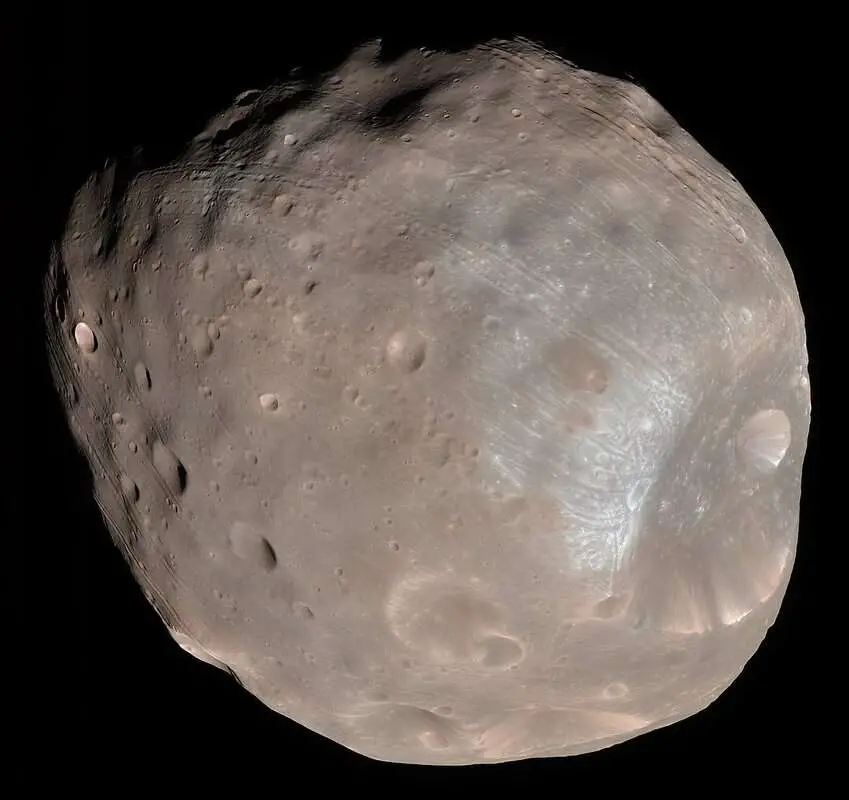German engineers have revealed how the new space rover, being built for a mission on one of Mars’s moons, will be able to cope on the satellite’s barely-there gravity.

The rover is being built with the ability to right itself from any position even on Phobos’s gravity pull of just 1/1000th of Earth’s.
The German Aerospace Center (DLR), which is building most of the rover set to be blasted off to the Martian moon Phobos, said in a statement obtained by Newsflash that they “are breaking new technical ground, because never before has a wheeled reconnaissance vehicle driven on a small celestial body that only has about one-thousandth the force of gravity.”
The mission, dubbed Martian Moons eXploration (MMX) and developed by the Japanese Aerospace Exploration Agency (JAXA), is set to land the rover on Phobos to retrieve samples and bring them back to Earth.
It will also conduct a fly-by of Mars’ other moon Deimos and monitor the Red Planet’s climate.

The Japanese space agency is working with the US’ NASA, the European Space Agency (ESA), the French space agency (CNES) and the German Aerospace Center (DLR) to develop the mission.
The rover, built by the German and French space agencies, “is expected to land on Phobos in 2027 as part of the Japanese MMX mission and will be active there for around 100 days”, according to the DLR.
The DLR has said that it has completed the rover’s carbon structure, “including the righting and locomotion system” and that it is also “providing two scientific instruments, a radiometer and a Raman spectrometer, as well as the connection and separation system to the mother ship”.
The DLR explained that little is known about the formation of the two moons of Mars, Phobos and Deimos.
The DLR said: “The Japanese space agency’s Martian Moons eXploration (MMX) mission is expected to start in 2024 to solve this mysteryJAXAto the two moons.
“A Franco-German rover will be on board, which will explore the surface of the approximately 27-kilometre-wide Phobos in detail.

“The German Aerospace Center (DLR) has now integrated and completed a significant part of the rover at the Bremen site. The carbon structure, which was created in cooperation with several DLR institutes, together with the righting and locomotion system, which was sent from Bremen to Toulouse, to the French space agency CNES, this week.
“There, the completion of the installation of all instruments and subsystems will take place by the summer of 2023. The MMX rover will also receive its radiometer miniRAD and its spectrometer RAX there. Both instruments were built at DLR in Berlin and had already been sent to Toulouse.”
Dr Markus Grebenstein from the DLR Institute for Robotics and Mechatronics in Oberpfaffenhofen, in charge of the DLR project management for the MMX rover, said: “With the MMX Rover we are breaking new technical ground, because never before has a wheeled reconnaissance vehicle driven on a small celestial body that only has about one-thousandth the force of gravity.”
He added: “Because the rover will be free-falling from the spacecraft onto Phobos, it will perform several ‘somersaults’ upon landing without injury and come to rest in an unpredictable position. From this situation, he has to stand up autonomously with the help of the drive system and then unfold his sun sails. Only then is the rover ready to drive and survive.”

Dr Stefan Barthelmes, from the DLR Institute for System Dynamics and Automatic Control in Oberpfaffenhofen, said: “After all, it will drive very carefully at just a few millimetres per second in order to maintain ground contact with its special wheels despite the low gravity.”
The rover, weighing just 25 kilogrammes (55 lbs), will separate from the mothership and fall 50 metres (164 feet) to the moon’s surface.
It will then have about 100 days to explore “the physical and mineralogical properties of the surface”.
The rover will also “determine the surface temperature using infrared measurements”.
This in turn will allow “conclusions to be drawn about the porosity of the surface material in order to compare it with asteroid and comet samples.”
The vehicle will also “determine the mineralogical composition of the Phobos surface along the rover route.”
The scientists hope to understand more about the formation and history of the moon and, comparing the data with other information gleaned by rovers on Mars, they hope that they can “better understand the Martian system and its moons”.
The next step is for the French CNES to install two special wheel cameras on the rover chassis in Toulouse over the next two months, according to the DLR.
The DLR said: “In addition to the two DLR instruments, two wheel cameras will also be installed at the CNES in Toulouse over the next few months.
“The engineering teams are also installing the solar panels, the power system, the radio system for contact with the earth and the on-board computer in the rover.

“Extensive testing of the complete rover will then follow in terms of its functionality and its resistance to the vibrations of the rocket launch and the extreme temperature fluctuations of more than 200 degrees Celsius on Phobos.”
Eventually, the goal is to retrieve samples from Phobos in 2027 and return them to Earth in 2029.
The moons Phobos and Deimos were discovered in 1877 by the American astronomer Asaph Hall. They were named after the sons of the Greek god of war Ares, whose nearest counterpart in Roman mythology is Mars.
Phobos is the god of fear and panic, while Deimos is the god of dread and terror.



